Business Environment: Tesco SWOT and Macro Factors Analysis
VerifiedAdded on 2020/02/03
|12
|4073
|586
Report
AI Summary
This report provides a comprehensive analysis of the business environment, focusing on the case of Tesco. It begins with an introduction to the business environment and key concepts, including different types of organizations such as public, private, and voluntary sectors, and their legal structures. The report then explores organizational structures like divisional, functional, and matrix structures, explaining the relationship between organizational functions and objectives. A significant portion of the report is dedicated to the impact of macro-environmental factors on business operations, with contemporary examples and a detailed examination of economic and non-economic environments, including demographic, governmental, social, natural, and technological factors. The report also includes an internal and external analysis of Tesco, employing a SWOT analysis to identify its strengths, weaknesses, opportunities, and threats, and explaining the interrelationship between these factors and the external macro environment. Finally, it concludes with a summary of the key findings and a list of references.
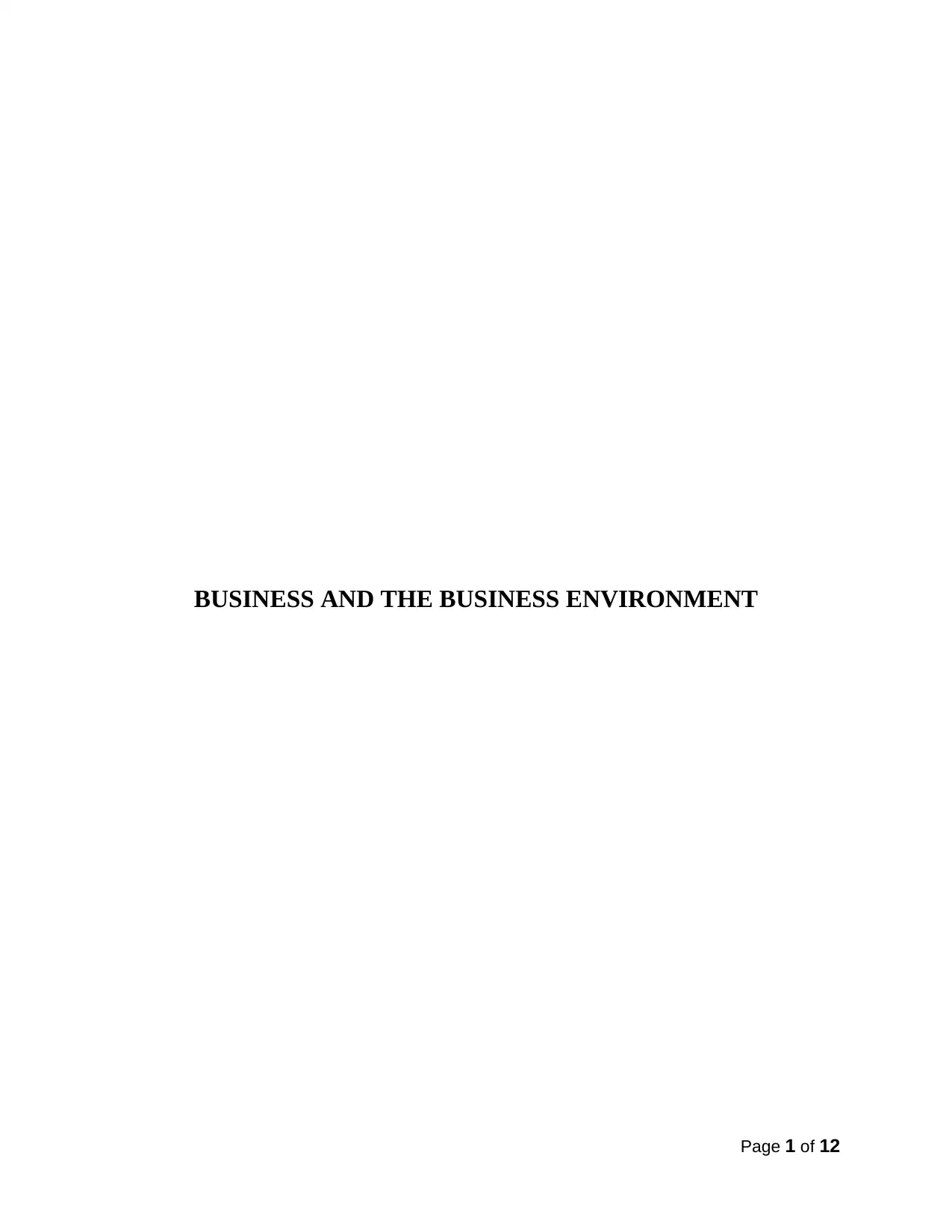
BUSINESS AND THE BUSINESS ENVIRONMENT
Page 1 of 12
Page 1 of 12
Paraphrase This Document
Need a fresh take? Get an instant paraphrase of this document with our AI Paraphraser
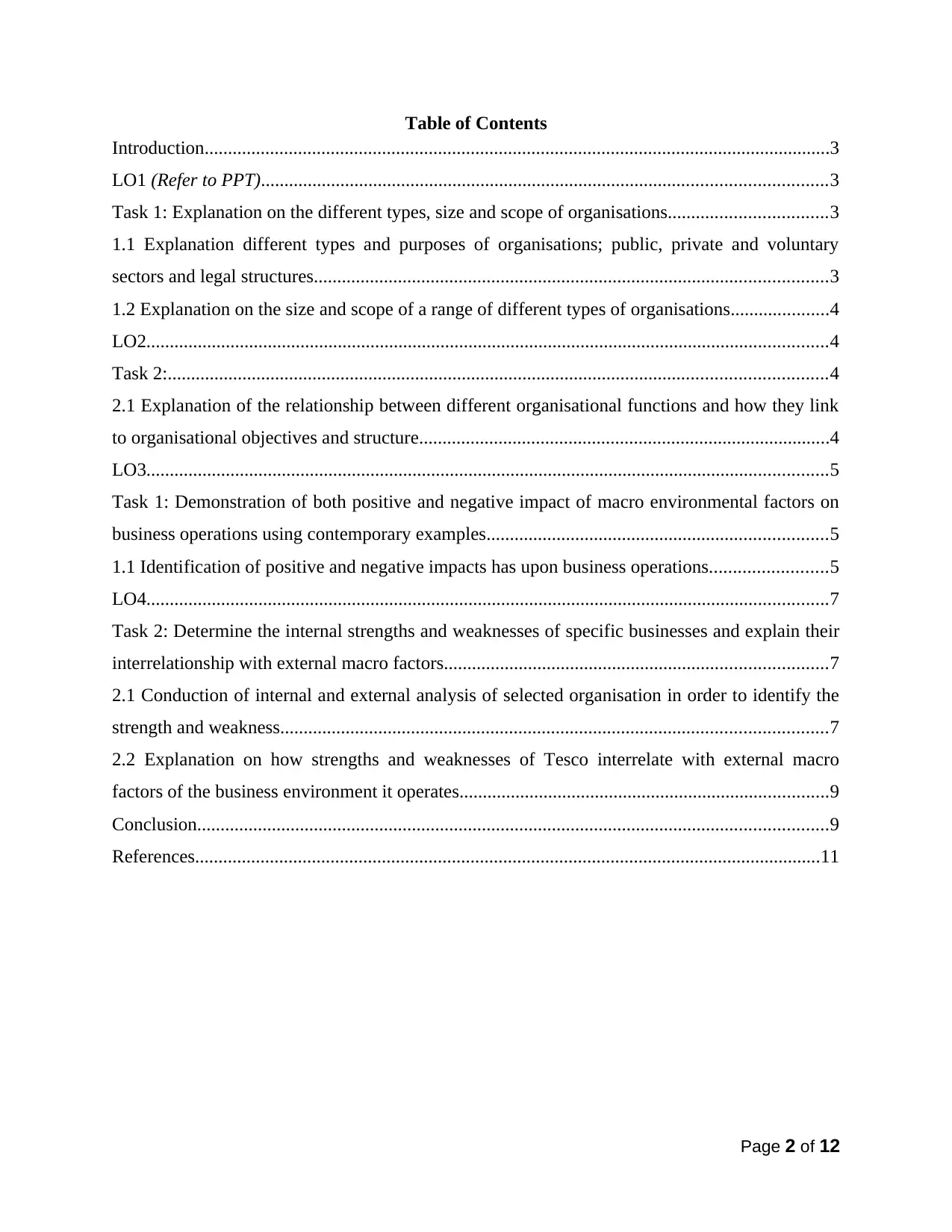
Table of Contents
Introduction......................................................................................................................................3
LO1 (Refer to PPT).........................................................................................................................3
Task 1: Explanation on the different types, size and scope of organisations..................................3
1.1 Explanation different types and purposes of organisations; public, private and voluntary
sectors and legal structures..............................................................................................................3
1.2 Explanation on the size and scope of a range of different types of organisations.....................4
LO2..................................................................................................................................................4
Task 2:.............................................................................................................................................4
2.1 Explanation of the relationship between different organisational functions and how they link
to organisational objectives and structure........................................................................................4
LO3..................................................................................................................................................5
Task 1: Demonstration of both positive and negative impact of macro environmental factors on
business operations using contemporary examples.........................................................................5
1.1 Identification of positive and negative impacts has upon business operations.........................5
LO4..................................................................................................................................................7
Task 2: Determine the internal strengths and weaknesses of specific businesses and explain their
interrelationship with external macro factors..................................................................................7
2.1 Conduction of internal and external analysis of selected organisation in order to identify the
strength and weakness.....................................................................................................................7
2.2 Explanation on how strengths and weaknesses of Tesco interrelate with external macro
factors of the business environment it operates...............................................................................9
Conclusion.......................................................................................................................................9
References......................................................................................................................................11
Page 2 of 12
Introduction......................................................................................................................................3
LO1 (Refer to PPT).........................................................................................................................3
Task 1: Explanation on the different types, size and scope of organisations..................................3
1.1 Explanation different types and purposes of organisations; public, private and voluntary
sectors and legal structures..............................................................................................................3
1.2 Explanation on the size and scope of a range of different types of organisations.....................4
LO2..................................................................................................................................................4
Task 2:.............................................................................................................................................4
2.1 Explanation of the relationship between different organisational functions and how they link
to organisational objectives and structure........................................................................................4
LO3..................................................................................................................................................5
Task 1: Demonstration of both positive and negative impact of macro environmental factors on
business operations using contemporary examples.........................................................................5
1.1 Identification of positive and negative impacts has upon business operations.........................5
LO4..................................................................................................................................................7
Task 2: Determine the internal strengths and weaknesses of specific businesses and explain their
interrelationship with external macro factors..................................................................................7
2.1 Conduction of internal and external analysis of selected organisation in order to identify the
strength and weakness.....................................................................................................................7
2.2 Explanation on how strengths and weaknesses of Tesco interrelate with external macro
factors of the business environment it operates...............................................................................9
Conclusion.......................................................................................................................................9
References......................................................................................................................................11
Page 2 of 12

Introduction
In the modern context of the business environment, it has been seen that the overall systems of
the human resources are dependent on the modern aspects of the transformations in the protocols
that are generally appointed by the managing individuals within the organisation. In this
assignment, the business background and the basic knowledge of business management are
discussed with the reference to a well-known company of the UK named Tesco and the effect of
macro-environmental factors on business firm management. The basic knowledge of SWOT
analysis, as an example the SWOT analysis of Tesco has also been given.
LO1 (Refer to PPT)
Task 1: Explanation on the different types, size and scope of organisations
1.1 Explanation different types and purposes of organisations; public, private and
voluntary sectors and legal structures
The organisation is a group or team of people with a particular aim, a business or any
governmental case. There are four types of organisational structure. These are - Public, private,
voluntary sectors and legal structures. Public sector organisation is Government based
organisation. It is mainly run by the Government of a country. People are paying taxes and this
amount is used to help many public sectors financially. The purposes of the public sector are to
use the resource completely to benefit the people of a country and fulfil the public services.
There are two types of Government in a country. One is Local Government and another is
Central Government. The purposes of local Government are Roads, Social services, Education,
Libraries, Parks and sports facilities (Sharma, 2014, p.9). The purposes of Central Government
are Social security, defence, Health service, Police, Universities.
Private sector organisations are run by private distinctive. The services of private sectors are
Companies, Franchises, Sole traders and partnerships. The purposes of this sector are the growth
and profit of the companies, maximising the sale, increasing the market share. Voluntary services
are not dependent on individuals. Anyone can make the responsibilities and budget to fulfil the
purpose. The purposes of this sector clothes for the poor people, stick or guide dogs for the
blinds etc. The legal structures of a business organisation are General partnership, sole
partnership, limited partnership, limited liability partnership, S Corporation, C Corporation, Non-
Profit Corporation (Samantara and Sharma, 2015, p.95).
Page 3 of 12
In the modern context of the business environment, it has been seen that the overall systems of
the human resources are dependent on the modern aspects of the transformations in the protocols
that are generally appointed by the managing individuals within the organisation. In this
assignment, the business background and the basic knowledge of business management are
discussed with the reference to a well-known company of the UK named Tesco and the effect of
macro-environmental factors on business firm management. The basic knowledge of SWOT
analysis, as an example the SWOT analysis of Tesco has also been given.
LO1 (Refer to PPT)
Task 1: Explanation on the different types, size and scope of organisations
1.1 Explanation different types and purposes of organisations; public, private and
voluntary sectors and legal structures
The organisation is a group or team of people with a particular aim, a business or any
governmental case. There are four types of organisational structure. These are - Public, private,
voluntary sectors and legal structures. Public sector organisation is Government based
organisation. It is mainly run by the Government of a country. People are paying taxes and this
amount is used to help many public sectors financially. The purposes of the public sector are to
use the resource completely to benefit the people of a country and fulfil the public services.
There are two types of Government in a country. One is Local Government and another is
Central Government. The purposes of local Government are Roads, Social services, Education,
Libraries, Parks and sports facilities (Sharma, 2014, p.9). The purposes of Central Government
are Social security, defence, Health service, Police, Universities.
Private sector organisations are run by private distinctive. The services of private sectors are
Companies, Franchises, Sole traders and partnerships. The purposes of this sector are the growth
and profit of the companies, maximising the sale, increasing the market share. Voluntary services
are not dependent on individuals. Anyone can make the responsibilities and budget to fulfil the
purpose. The purposes of this sector clothes for the poor people, stick or guide dogs for the
blinds etc. The legal structures of a business organisation are General partnership, sole
partnership, limited partnership, limited liability partnership, S Corporation, C Corporation, Non-
Profit Corporation (Samantara and Sharma, 2015, p.95).
Page 3 of 12
⊘ This is a preview!⊘
Do you want full access?
Subscribe today to unlock all pages.

Trusted by 1+ million students worldwide
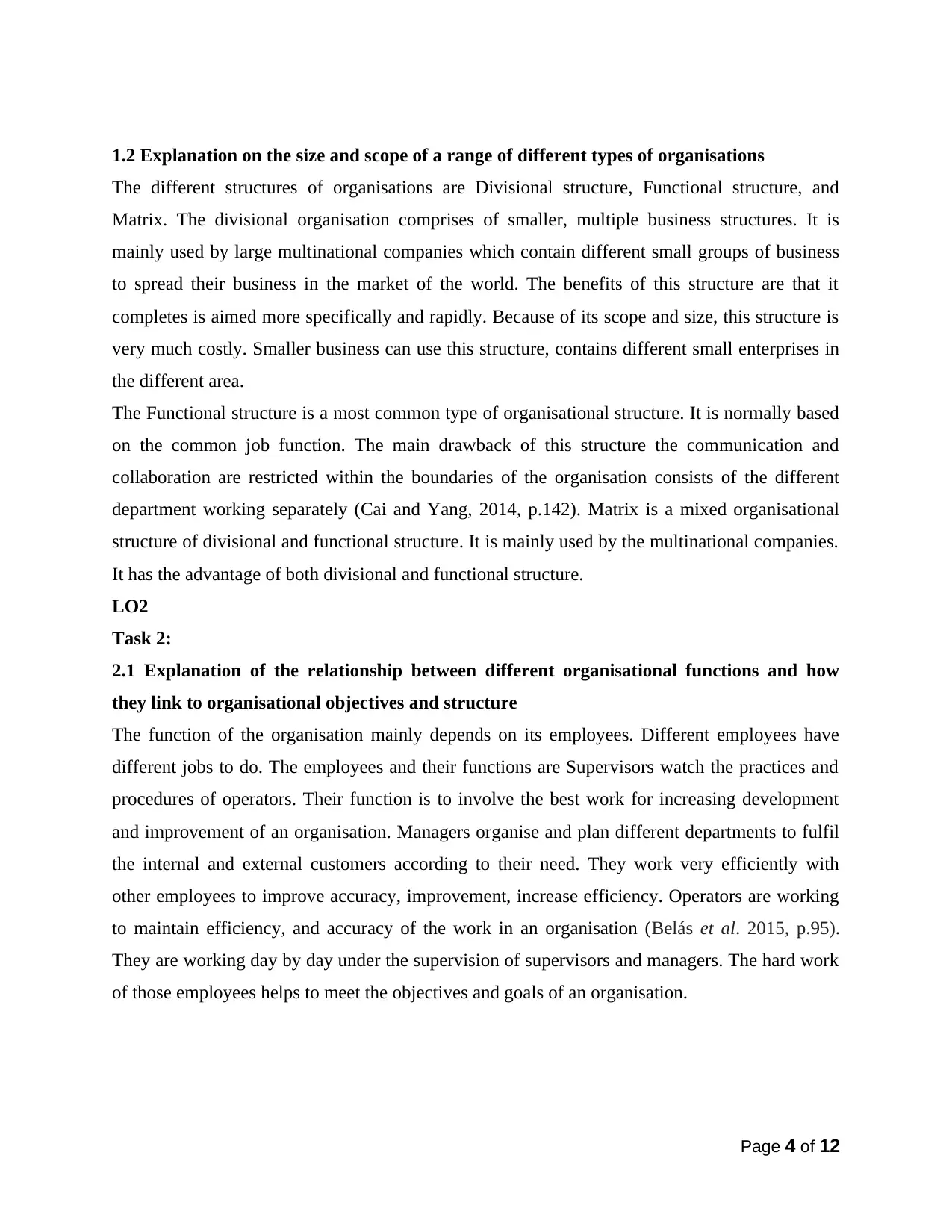
1.2 Explanation on the size and scope of a range of different types of organisations
The different structures of organisations are Divisional structure, Functional structure, and
Matrix. The divisional organisation comprises of smaller, multiple business structures. It is
mainly used by large multinational companies which contain different small groups of business
to spread their business in the market of the world. The benefits of this structure are that it
completes is aimed more specifically and rapidly. Because of its scope and size, this structure is
very much costly. Smaller business can use this structure, contains different small enterprises in
the different area.
The Functional structure is a most common type of organisational structure. It is normally based
on the common job function. The main drawback of this structure the communication and
collaboration are restricted within the boundaries of the organisation consists of the different
department working separately (Cai and Yang, 2014, p.142). Matrix is a mixed organisational
structure of divisional and functional structure. It is mainly used by the multinational companies.
It has the advantage of both divisional and functional structure.
LO2
Task 2:
2.1 Explanation of the relationship between different organisational functions and how
they link to organisational objectives and structure
The function of the organisation mainly depends on its employees. Different employees have
different jobs to do. The employees and their functions are Supervisors watch the practices and
procedures of operators. Their function is to involve the best work for increasing development
and improvement of an organisation. Managers organise and plan different departments to fulfil
the internal and external customers according to their need. They work very efficiently with
other employees to improve accuracy, improvement, increase efficiency. Operators are working
to maintain efficiency, and accuracy of the work in an organisation (Belás et al. 2015, p.95).
They are working day by day under the supervision of supervisors and managers. The hard work
of those employees helps to meet the objectives and goals of an organisation.
Page 4 of 12
The different structures of organisations are Divisional structure, Functional structure, and
Matrix. The divisional organisation comprises of smaller, multiple business structures. It is
mainly used by large multinational companies which contain different small groups of business
to spread their business in the market of the world. The benefits of this structure are that it
completes is aimed more specifically and rapidly. Because of its scope and size, this structure is
very much costly. Smaller business can use this structure, contains different small enterprises in
the different area.
The Functional structure is a most common type of organisational structure. It is normally based
on the common job function. The main drawback of this structure the communication and
collaboration are restricted within the boundaries of the organisation consists of the different
department working separately (Cai and Yang, 2014, p.142). Matrix is a mixed organisational
structure of divisional and functional structure. It is mainly used by the multinational companies.
It has the advantage of both divisional and functional structure.
LO2
Task 2:
2.1 Explanation of the relationship between different organisational functions and how
they link to organisational objectives and structure
The function of the organisation mainly depends on its employees. Different employees have
different jobs to do. The employees and their functions are Supervisors watch the practices and
procedures of operators. Their function is to involve the best work for increasing development
and improvement of an organisation. Managers organise and plan different departments to fulfil
the internal and external customers according to their need. They work very efficiently with
other employees to improve accuracy, improvement, increase efficiency. Operators are working
to maintain efficiency, and accuracy of the work in an organisation (Belás et al. 2015, p.95).
They are working day by day under the supervision of supervisors and managers. The hard work
of those employees helps to meet the objectives and goals of an organisation.
Page 4 of 12
Paraphrase This Document
Need a fresh take? Get an instant paraphrase of this document with our AI Paraphraser
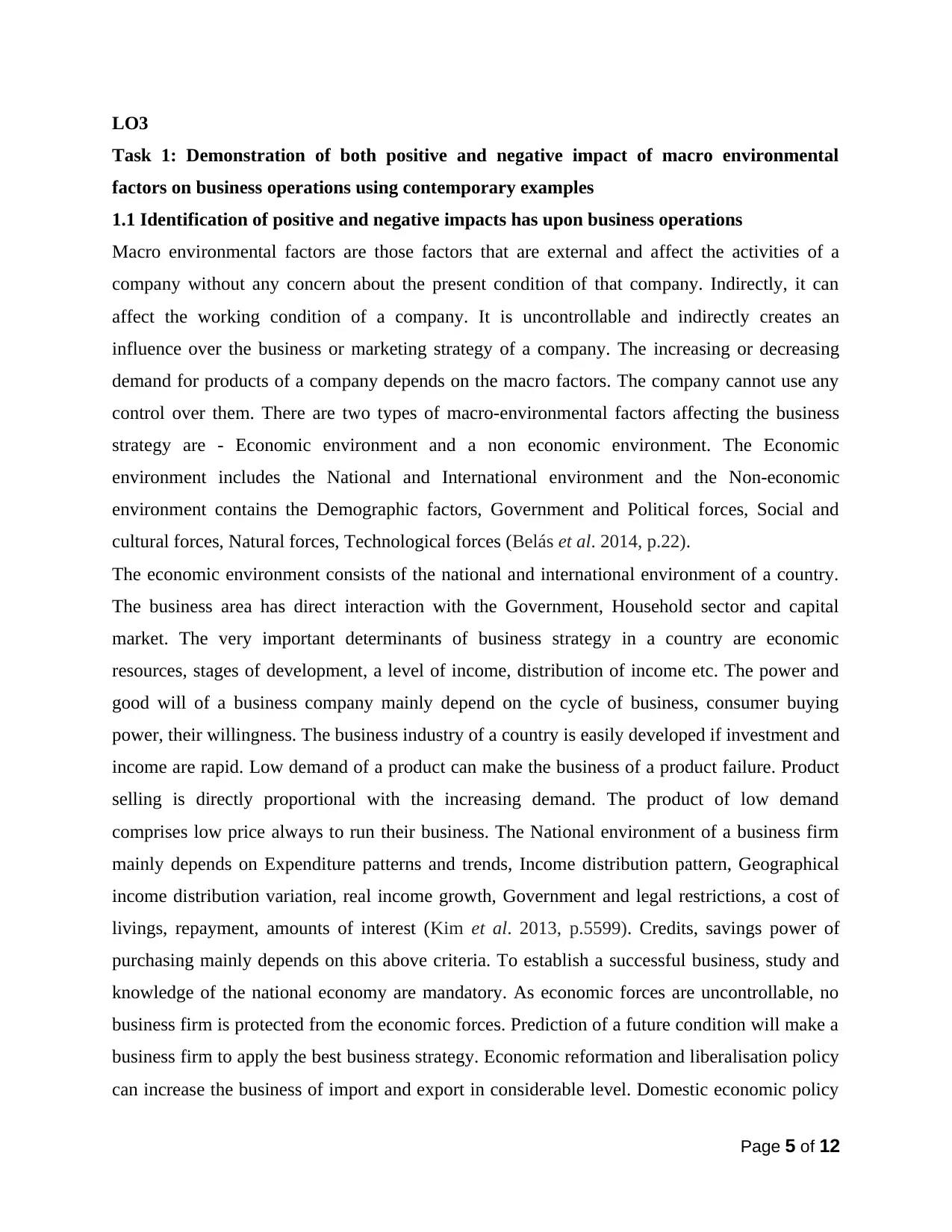
LO3
Task 1: Demonstration of both positive and negative impact of macro environmental
factors on business operations using contemporary examples
1.1 Identification of positive and negative impacts has upon business operations
Macro environmental factors are those factors that are external and affect the activities of a
company without any concern about the present condition of that company. Indirectly, it can
affect the working condition of a company. It is uncontrollable and indirectly creates an
influence over the business or marketing strategy of a company. The increasing or decreasing
demand for products of a company depends on the macro factors. The company cannot use any
control over them. There are two types of macro-environmental factors affecting the business
strategy are - Economic environment and a non economic environment. The Economic
environment includes the National and International environment and the Non-economic
environment contains the Demographic factors, Government and Political forces, Social and
cultural forces, Natural forces, Technological forces (Belás et al. 2014, p.22).
The economic environment consists of the national and international environment of a country.
The business area has direct interaction with the Government, Household sector and capital
market. The very important determinants of business strategy in a country are economic
resources, stages of development, a level of income, distribution of income etc. The power and
good will of a business company mainly depend on the cycle of business, consumer buying
power, their willingness. The business industry of a country is easily developed if investment and
income are rapid. Low demand of a product can make the business of a product failure. Product
selling is directly proportional with the increasing demand. The product of low demand
comprises low price always to run their business. The National environment of a business firm
mainly depends on Expenditure patterns and trends, Income distribution pattern, Geographical
income distribution variation, real income growth, Government and legal restrictions, a cost of
livings, repayment, amounts of interest (Kim et al. 2013, p.5599). Credits, savings power of
purchasing mainly depends on this above criteria. To establish a successful business, study and
knowledge of the national economy are mandatory. As economic forces are uncontrollable, no
business firm is protected from the economic forces. Prediction of a future condition will make a
business firm to apply the best business strategy. Economic reformation and liberalisation policy
can increase the business of import and export in considerable level. Domestic economic policy
Page 5 of 12
Task 1: Demonstration of both positive and negative impact of macro environmental
factors on business operations using contemporary examples
1.1 Identification of positive and negative impacts has upon business operations
Macro environmental factors are those factors that are external and affect the activities of a
company without any concern about the present condition of that company. Indirectly, it can
affect the working condition of a company. It is uncontrollable and indirectly creates an
influence over the business or marketing strategy of a company. The increasing or decreasing
demand for products of a company depends on the macro factors. The company cannot use any
control over them. There are two types of macro-environmental factors affecting the business
strategy are - Economic environment and a non economic environment. The Economic
environment includes the National and International environment and the Non-economic
environment contains the Demographic factors, Government and Political forces, Social and
cultural forces, Natural forces, Technological forces (Belás et al. 2014, p.22).
The economic environment consists of the national and international environment of a country.
The business area has direct interaction with the Government, Household sector and capital
market. The very important determinants of business strategy in a country are economic
resources, stages of development, a level of income, distribution of income etc. The power and
good will of a business company mainly depend on the cycle of business, consumer buying
power, their willingness. The business industry of a country is easily developed if investment and
income are rapid. Low demand of a product can make the business of a product failure. Product
selling is directly proportional with the increasing demand. The product of low demand
comprises low price always to run their business. The National environment of a business firm
mainly depends on Expenditure patterns and trends, Income distribution pattern, Geographical
income distribution variation, real income growth, Government and legal restrictions, a cost of
livings, repayment, amounts of interest (Kim et al. 2013, p.5599). Credits, savings power of
purchasing mainly depends on this above criteria. To establish a successful business, study and
knowledge of the national economy are mandatory. As economic forces are uncontrollable, no
business firm is protected from the economic forces. Prediction of a future condition will make a
business firm to apply the best business strategy. Economic reformation and liberalisation policy
can increase the business of import and export in considerable level. Domestic economic policy
Page 5 of 12
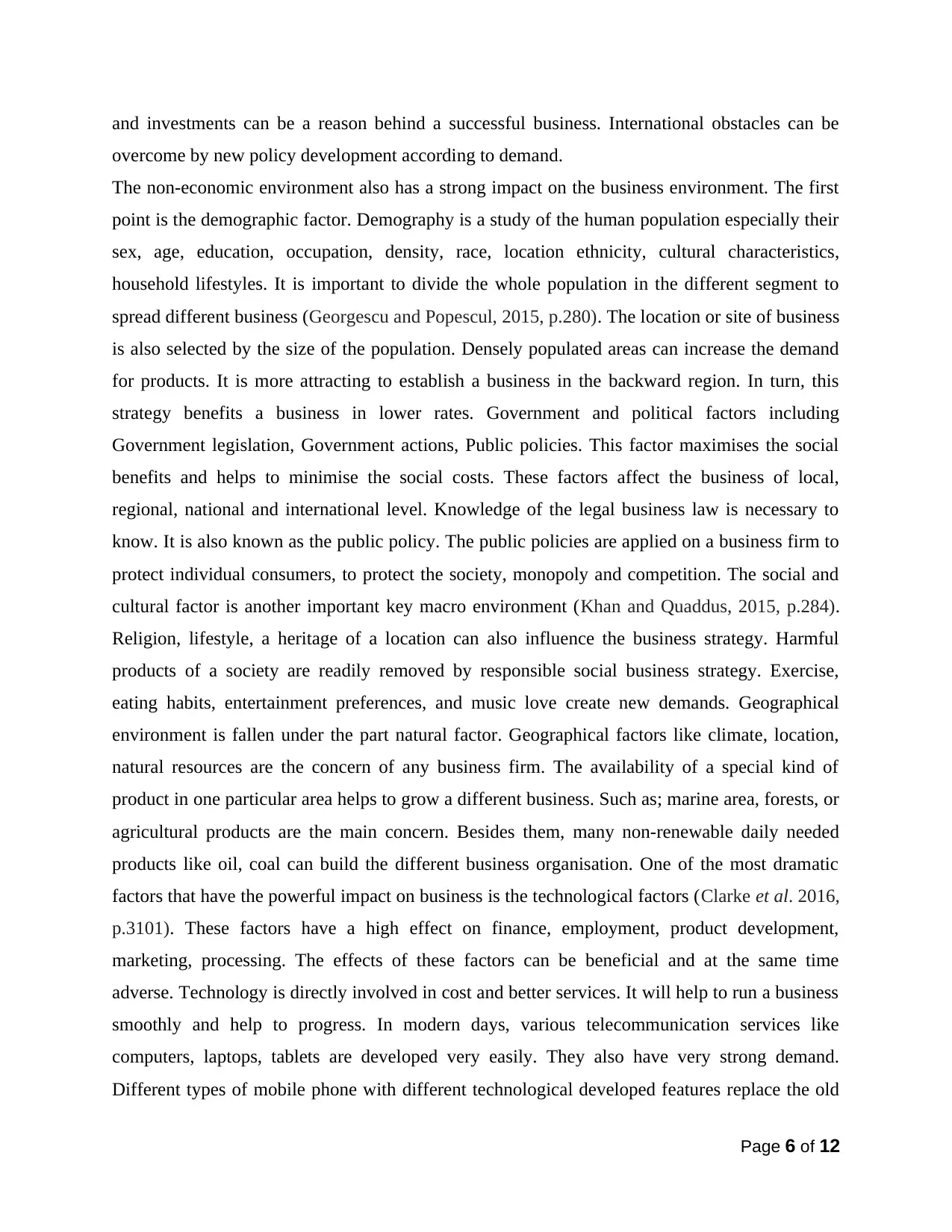
and investments can be a reason behind a successful business. International obstacles can be
overcome by new policy development according to demand.
The non-economic environment also has a strong impact on the business environment. The first
point is the demographic factor. Demography is a study of the human population especially their
sex, age, education, occupation, density, race, location ethnicity, cultural characteristics,
household lifestyles. It is important to divide the whole population in the different segment to
spread different business (Georgescu and Popescul, 2015, p.280). The location or site of business
is also selected by the size of the population. Densely populated areas can increase the demand
for products. It is more attracting to establish a business in the backward region. In turn, this
strategy benefits a business in lower rates. Government and political factors including
Government legislation, Government actions, Public policies. This factor maximises the social
benefits and helps to minimise the social costs. These factors affect the business of local,
regional, national and international level. Knowledge of the legal business law is necessary to
know. It is also known as the public policy. The public policies are applied on a business firm to
protect individual consumers, to protect the society, monopoly and competition. The social and
cultural factor is another important key macro environment (Khan and Quaddus, 2015, p.284).
Religion, lifestyle, a heritage of a location can also influence the business strategy. Harmful
products of a society are readily removed by responsible social business strategy. Exercise,
eating habits, entertainment preferences, and music love create new demands. Geographical
environment is fallen under the part natural factor. Geographical factors like climate, location,
natural resources are the concern of any business firm. The availability of a special kind of
product in one particular area helps to grow a different business. Such as; marine area, forests, or
agricultural products are the main concern. Besides them, many non-renewable daily needed
products like oil, coal can build the different business organisation. One of the most dramatic
factors that have the powerful impact on business is the technological factors (Clarke et al. 2016,
p.3101). These factors have a high effect on finance, employment, product development,
marketing, processing. The effects of these factors can be beneficial and at the same time
adverse. Technology is directly involved in cost and better services. It will help to run a business
smoothly and help to progress. In modern days, various telecommunication services like
computers, laptops, tablets are developed very easily. They also have very strong demand.
Different types of mobile phone with different technological developed features replace the old
Page 6 of 12
overcome by new policy development according to demand.
The non-economic environment also has a strong impact on the business environment. The first
point is the demographic factor. Demography is a study of the human population especially their
sex, age, education, occupation, density, race, location ethnicity, cultural characteristics,
household lifestyles. It is important to divide the whole population in the different segment to
spread different business (Georgescu and Popescul, 2015, p.280). The location or site of business
is also selected by the size of the population. Densely populated areas can increase the demand
for products. It is more attracting to establish a business in the backward region. In turn, this
strategy benefits a business in lower rates. Government and political factors including
Government legislation, Government actions, Public policies. This factor maximises the social
benefits and helps to minimise the social costs. These factors affect the business of local,
regional, national and international level. Knowledge of the legal business law is necessary to
know. It is also known as the public policy. The public policies are applied on a business firm to
protect individual consumers, to protect the society, monopoly and competition. The social and
cultural factor is another important key macro environment (Khan and Quaddus, 2015, p.284).
Religion, lifestyle, a heritage of a location can also influence the business strategy. Harmful
products of a society are readily removed by responsible social business strategy. Exercise,
eating habits, entertainment preferences, and music love create new demands. Geographical
environment is fallen under the part natural factor. Geographical factors like climate, location,
natural resources are the concern of any business firm. The availability of a special kind of
product in one particular area helps to grow a different business. Such as; marine area, forests, or
agricultural products are the main concern. Besides them, many non-renewable daily needed
products like oil, coal can build the different business organisation. One of the most dramatic
factors that have the powerful impact on business is the technological factors (Clarke et al. 2016,
p.3101). These factors have a high effect on finance, employment, product development,
marketing, processing. The effects of these factors can be beneficial and at the same time
adverse. Technology is directly involved in cost and better services. It will help to run a business
smoothly and help to progress. In modern days, various telecommunication services like
computers, laptops, tablets are developed very easily. They also have very strong demand.
Different types of mobile phone with different technological developed features replace the old
Page 6 of 12
⊘ This is a preview!⊘
Do you want full access?
Subscribe today to unlock all pages.

Trusted by 1+ million students worldwide
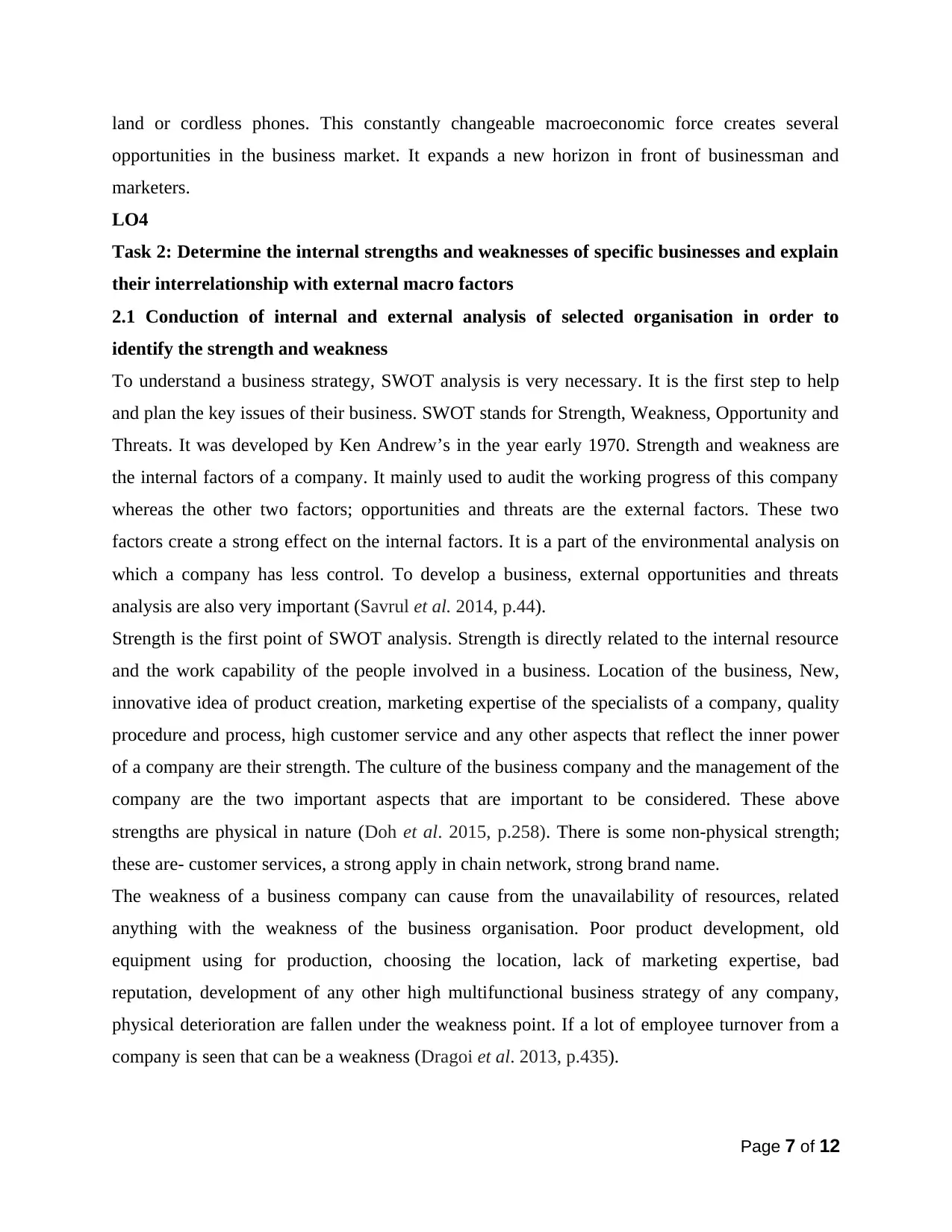
land or cordless phones. This constantly changeable macroeconomic force creates several
opportunities in the business market. It expands a new horizon in front of businessman and
marketers.
LO4
Task 2: Determine the internal strengths and weaknesses of specific businesses and explain
their interrelationship with external macro factors
2.1 Conduction of internal and external analysis of selected organisation in order to
identify the strength and weakness
To understand a business strategy, SWOT analysis is very necessary. It is the first step to help
and plan the key issues of their business. SWOT stands for Strength, Weakness, Opportunity and
Threats. It was developed by Ken Andrew’s in the year early 1970. Strength and weakness are
the internal factors of a company. It mainly used to audit the working progress of this company
whereas the other two factors; opportunities and threats are the external factors. These two
factors create a strong effect on the internal factors. It is a part of the environmental analysis on
which a company has less control. To develop a business, external opportunities and threats
analysis are also very important (Savrul et al. 2014, p.44).
Strength is the first point of SWOT analysis. Strength is directly related to the internal resource
and the work capability of the people involved in a business. Location of the business, New,
innovative idea of product creation, marketing expertise of the specialists of a company, quality
procedure and process, high customer service and any other aspects that reflect the inner power
of a company are their strength. The culture of the business company and the management of the
company are the two important aspects that are important to be considered. These above
strengths are physical in nature (Doh et al. 2015, p.258). There is some non-physical strength;
these are- customer services, a strong apply in chain network, strong brand name.
The weakness of a business company can cause from the unavailability of resources, related
anything with the weakness of the business organisation. Poor product development, old
equipment using for production, choosing the location, lack of marketing expertise, bad
reputation, development of any other high multifunctional business strategy of any company,
physical deterioration are fallen under the weakness point. If a lot of employee turnover from a
company is seen that can be a weakness (Dragoi et al. 2013, p.435).
Page 7 of 12
opportunities in the business market. It expands a new horizon in front of businessman and
marketers.
LO4
Task 2: Determine the internal strengths and weaknesses of specific businesses and explain
their interrelationship with external macro factors
2.1 Conduction of internal and external analysis of selected organisation in order to
identify the strength and weakness
To understand a business strategy, SWOT analysis is very necessary. It is the first step to help
and plan the key issues of their business. SWOT stands for Strength, Weakness, Opportunity and
Threats. It was developed by Ken Andrew’s in the year early 1970. Strength and weakness are
the internal factors of a company. It mainly used to audit the working progress of this company
whereas the other two factors; opportunities and threats are the external factors. These two
factors create a strong effect on the internal factors. It is a part of the environmental analysis on
which a company has less control. To develop a business, external opportunities and threats
analysis are also very important (Savrul et al. 2014, p.44).
Strength is the first point of SWOT analysis. Strength is directly related to the internal resource
and the work capability of the people involved in a business. Location of the business, New,
innovative idea of product creation, marketing expertise of the specialists of a company, quality
procedure and process, high customer service and any other aspects that reflect the inner power
of a company are their strength. The culture of the business company and the management of the
company are the two important aspects that are important to be considered. These above
strengths are physical in nature (Doh et al. 2015, p.258). There is some non-physical strength;
these are- customer services, a strong apply in chain network, strong brand name.
The weakness of a business company can cause from the unavailability of resources, related
anything with the weakness of the business organisation. Poor product development, old
equipment using for production, choosing the location, lack of marketing expertise, bad
reputation, development of any other high multifunctional business strategy of any company,
physical deterioration are fallen under the weakness point. If a lot of employee turnover from a
company is seen that can be a weakness (Dragoi et al. 2013, p.435).
Page 7 of 12
Paraphrase This Document
Need a fresh take? Get an instant paraphrase of this document with our AI Paraphraser
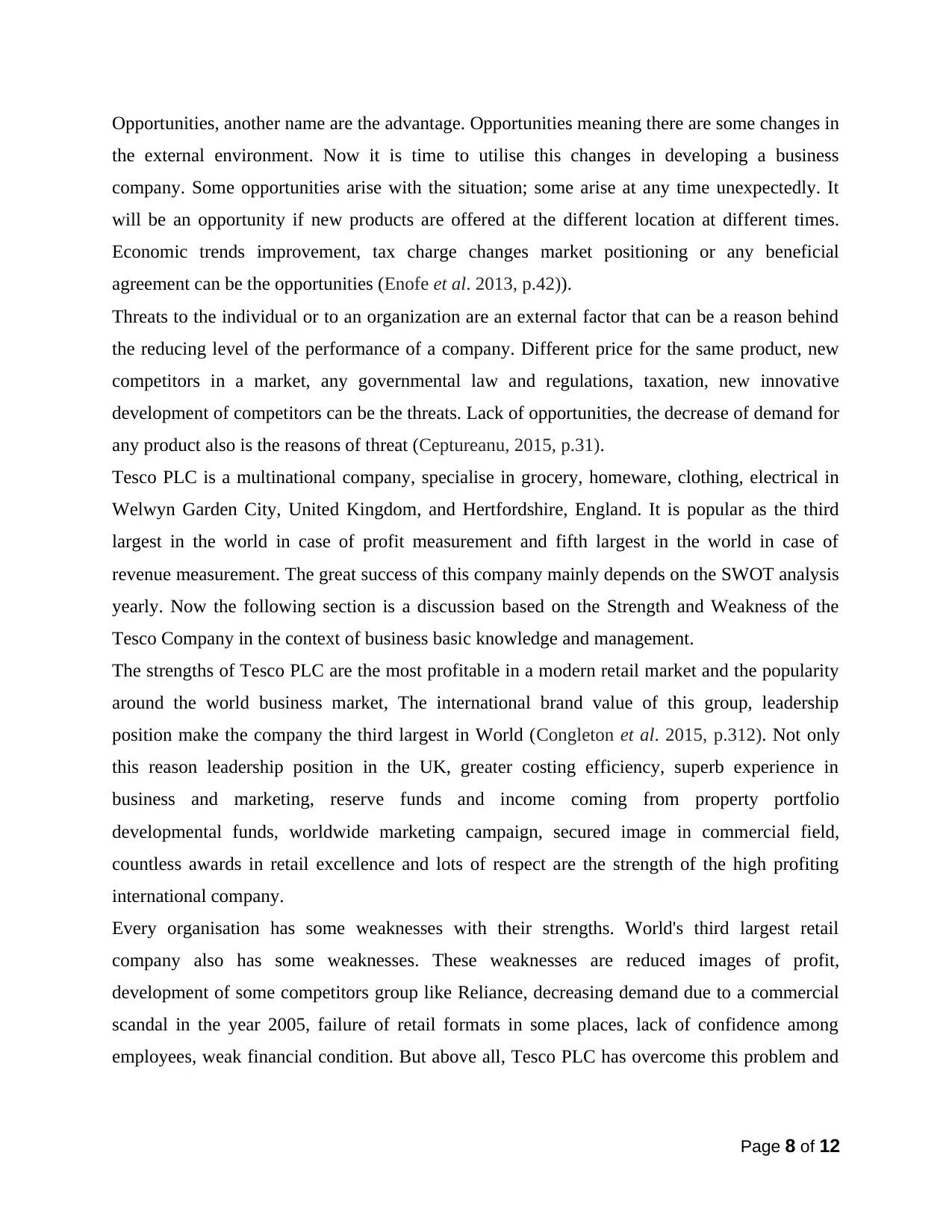
Opportunities, another name are the advantage. Opportunities meaning there are some changes in
the external environment. Now it is time to utilise this changes in developing a business
company. Some opportunities arise with the situation; some arise at any time unexpectedly. It
will be an opportunity if new products are offered at the different location at different times.
Economic trends improvement, tax charge changes market positioning or any beneficial
agreement can be the opportunities (Enofe et al. 2013, p.42)).
Threats to the individual or to an organization are an external factor that can be a reason behind
the reducing level of the performance of a company. Different price for the same product, new
competitors in a market, any governmental law and regulations, taxation, new innovative
development of competitors can be the threats. Lack of opportunities, the decrease of demand for
any product also is the reasons of threat (Ceptureanu, 2015, p.31).
Tesco PLC is a multinational company, specialise in grocery, homeware, clothing, electrical in
Welwyn Garden City, United Kingdom, and Hertfordshire, England. It is popular as the third
largest in the world in case of profit measurement and fifth largest in the world in case of
revenue measurement. The great success of this company mainly depends on the SWOT analysis
yearly. Now the following section is a discussion based on the Strength and Weakness of the
Tesco Company in the context of business basic knowledge and management.
The strengths of Tesco PLC are the most profitable in a modern retail market and the popularity
around the world business market, The international brand value of this group, leadership
position make the company the third largest in World (Congleton et al. 2015, p.312). Not only
this reason leadership position in the UK, greater costing efficiency, superb experience in
business and marketing, reserve funds and income coming from property portfolio
developmental funds, worldwide marketing campaign, secured image in commercial field,
countless awards in retail excellence and lots of respect are the strength of the high profiting
international company.
Every organisation has some weaknesses with their strengths. World's third largest retail
company also has some weaknesses. These weaknesses are reduced images of profit,
development of some competitors group like Reliance, decreasing demand due to a commercial
scandal in the year 2005, failure of retail formats in some places, lack of confidence among
employees, weak financial condition. But above all, Tesco PLC has overcome this problem and
Page 8 of 12
the external environment. Now it is time to utilise this changes in developing a business
company. Some opportunities arise with the situation; some arise at any time unexpectedly. It
will be an opportunity if new products are offered at the different location at different times.
Economic trends improvement, tax charge changes market positioning or any beneficial
agreement can be the opportunities (Enofe et al. 2013, p.42)).
Threats to the individual or to an organization are an external factor that can be a reason behind
the reducing level of the performance of a company. Different price for the same product, new
competitors in a market, any governmental law and regulations, taxation, new innovative
development of competitors can be the threats. Lack of opportunities, the decrease of demand for
any product also is the reasons of threat (Ceptureanu, 2015, p.31).
Tesco PLC is a multinational company, specialise in grocery, homeware, clothing, electrical in
Welwyn Garden City, United Kingdom, and Hertfordshire, England. It is popular as the third
largest in the world in case of profit measurement and fifth largest in the world in case of
revenue measurement. The great success of this company mainly depends on the SWOT analysis
yearly. Now the following section is a discussion based on the Strength and Weakness of the
Tesco Company in the context of business basic knowledge and management.
The strengths of Tesco PLC are the most profitable in a modern retail market and the popularity
around the world business market, The international brand value of this group, leadership
position make the company the third largest in World (Congleton et al. 2015, p.312). Not only
this reason leadership position in the UK, greater costing efficiency, superb experience in
business and marketing, reserve funds and income coming from property portfolio
developmental funds, worldwide marketing campaign, secured image in commercial field,
countless awards in retail excellence and lots of respect are the strength of the high profiting
international company.
Every organisation has some weaknesses with their strengths. World's third largest retail
company also has some weaknesses. These weaknesses are reduced images of profit,
development of some competitors group like Reliance, decreasing demand due to a commercial
scandal in the year 2005, failure of retail formats in some places, lack of confidence among
employees, weak financial condition. But above all, Tesco PLC has overcome this problem and
Page 8 of 12
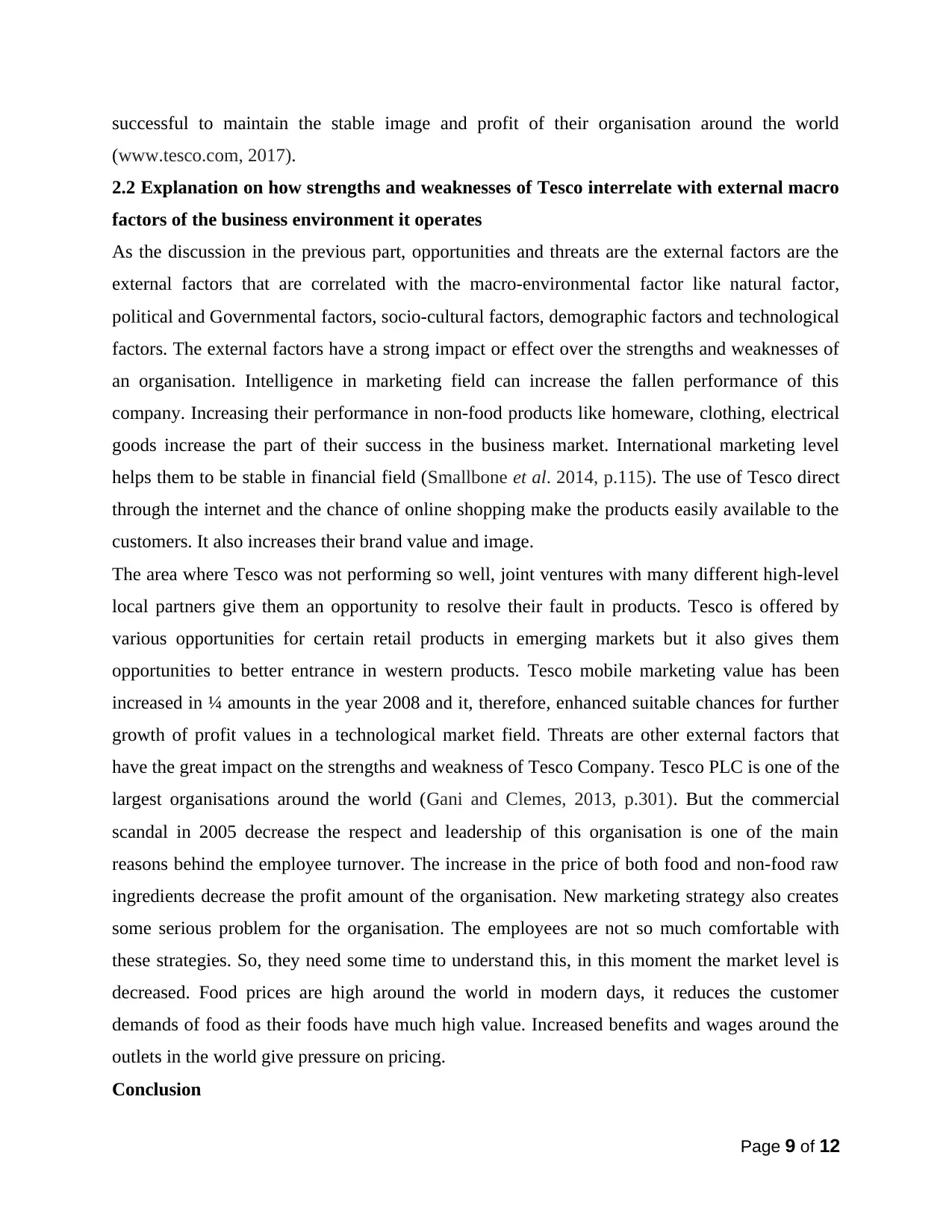
successful to maintain the stable image and profit of their organisation around the world
(www.tesco.com, 2017).
2.2 Explanation on how strengths and weaknesses of Tesco interrelate with external macro
factors of the business environment it operates
As the discussion in the previous part, opportunities and threats are the external factors are the
external factors that are correlated with the macro-environmental factor like natural factor,
political and Governmental factors, socio-cultural factors, demographic factors and technological
factors. The external factors have a strong impact or effect over the strengths and weaknesses of
an organisation. Intelligence in marketing field can increase the fallen performance of this
company. Increasing their performance in non-food products like homeware, clothing, electrical
goods increase the part of their success in the business market. International marketing level
helps them to be stable in financial field (Smallbone et al. 2014, p.115). The use of Tesco direct
through the internet and the chance of online shopping make the products easily available to the
customers. It also increases their brand value and image.
The area where Tesco was not performing so well, joint ventures with many different high-level
local partners give them an opportunity to resolve their fault in products. Tesco is offered by
various opportunities for certain retail products in emerging markets but it also gives them
opportunities to better entrance in western products. Tesco mobile marketing value has been
increased in ¼ amounts in the year 2008 and it, therefore, enhanced suitable chances for further
growth of profit values in a technological market field. Threats are other external factors that
have the great impact on the strengths and weakness of Tesco Company. Tesco PLC is one of the
largest organisations around the world (Gani and Clemes, 2013, p.301). But the commercial
scandal in 2005 decrease the respect and leadership of this organisation is one of the main
reasons behind the employee turnover. The increase in the price of both food and non-food raw
ingredients decrease the profit amount of the organisation. New marketing strategy also creates
some serious problem for the organisation. The employees are not so much comfortable with
these strategies. So, they need some time to understand this, in this moment the market level is
decreased. Food prices are high around the world in modern days, it reduces the customer
demands of food as their foods have much high value. Increased benefits and wages around the
outlets in the world give pressure on pricing.
Conclusion
Page 9 of 12
(www.tesco.com, 2017).
2.2 Explanation on how strengths and weaknesses of Tesco interrelate with external macro
factors of the business environment it operates
As the discussion in the previous part, opportunities and threats are the external factors are the
external factors that are correlated with the macro-environmental factor like natural factor,
political and Governmental factors, socio-cultural factors, demographic factors and technological
factors. The external factors have a strong impact or effect over the strengths and weaknesses of
an organisation. Intelligence in marketing field can increase the fallen performance of this
company. Increasing their performance in non-food products like homeware, clothing, electrical
goods increase the part of their success in the business market. International marketing level
helps them to be stable in financial field (Smallbone et al. 2014, p.115). The use of Tesco direct
through the internet and the chance of online shopping make the products easily available to the
customers. It also increases their brand value and image.
The area where Tesco was not performing so well, joint ventures with many different high-level
local partners give them an opportunity to resolve their fault in products. Tesco is offered by
various opportunities for certain retail products in emerging markets but it also gives them
opportunities to better entrance in western products. Tesco mobile marketing value has been
increased in ¼ amounts in the year 2008 and it, therefore, enhanced suitable chances for further
growth of profit values in a technological market field. Threats are other external factors that
have the great impact on the strengths and weakness of Tesco Company. Tesco PLC is one of the
largest organisations around the world (Gani and Clemes, 2013, p.301). But the commercial
scandal in 2005 decrease the respect and leadership of this organisation is one of the main
reasons behind the employee turnover. The increase in the price of both food and non-food raw
ingredients decrease the profit amount of the organisation. New marketing strategy also creates
some serious problem for the organisation. The employees are not so much comfortable with
these strategies. So, they need some time to understand this, in this moment the market level is
decreased. Food prices are high around the world in modern days, it reduces the customer
demands of food as their foods have much high value. Increased benefits and wages around the
outlets in the world give pressure on pricing.
Conclusion
Page 9 of 12
⊘ This is a preview!⊘
Do you want full access?
Subscribe today to unlock all pages.

Trusted by 1+ million students worldwide
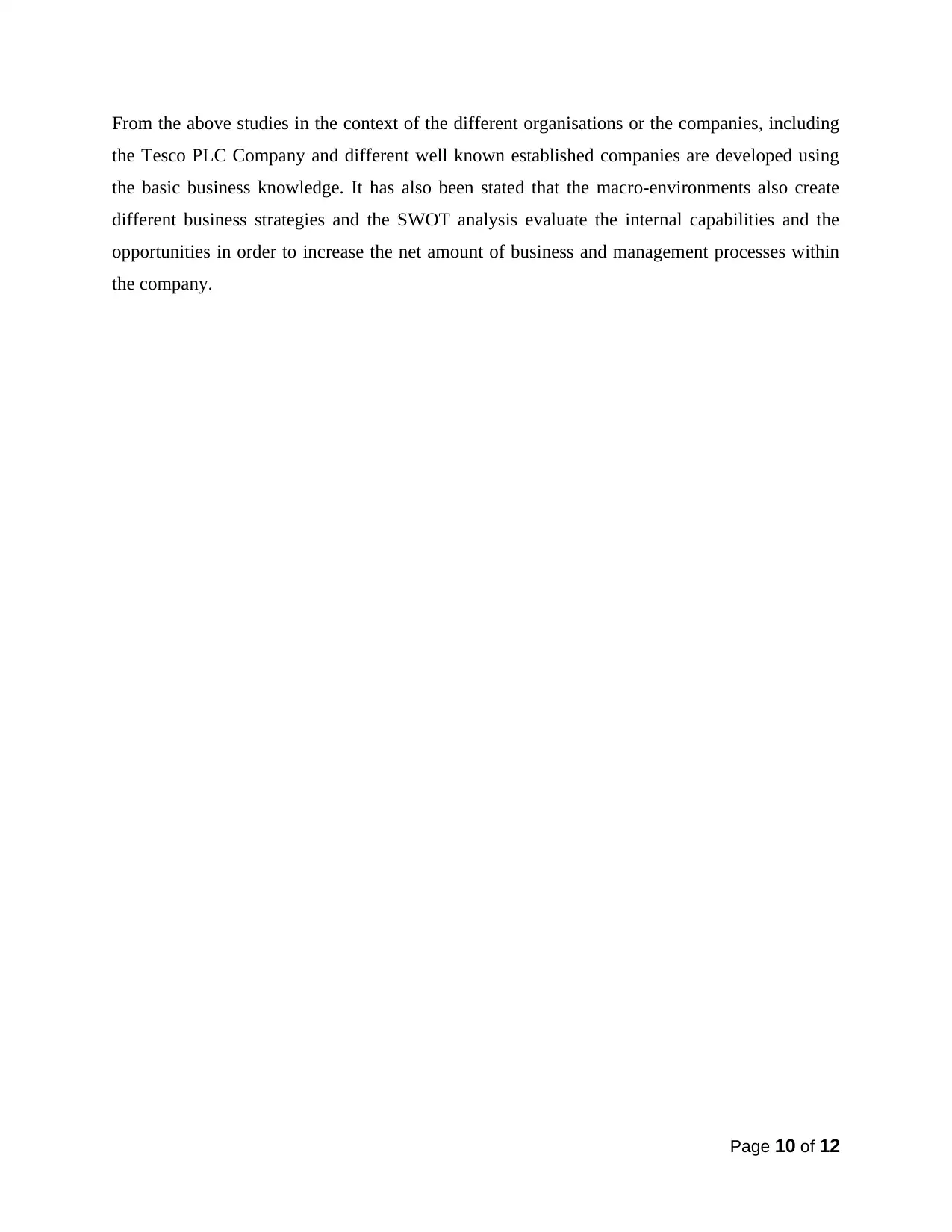
From the above studies in the context of the different organisations or the companies, including
the Tesco PLC Company and different well known established companies are developed using
the basic business knowledge. It has also been stated that the macro-environments also create
different business strategies and the SWOT analysis evaluate the internal capabilities and the
opportunities in order to increase the net amount of business and management processes within
the company.
Page 10 of 12
the Tesco PLC Company and different well known established companies are developed using
the basic business knowledge. It has also been stated that the macro-environments also create
different business strategies and the SWOT analysis evaluate the internal capabilities and the
opportunities in order to increase the net amount of business and management processes within
the company.
Page 10 of 12
Paraphrase This Document
Need a fresh take? Get an instant paraphrase of this document with our AI Paraphraser
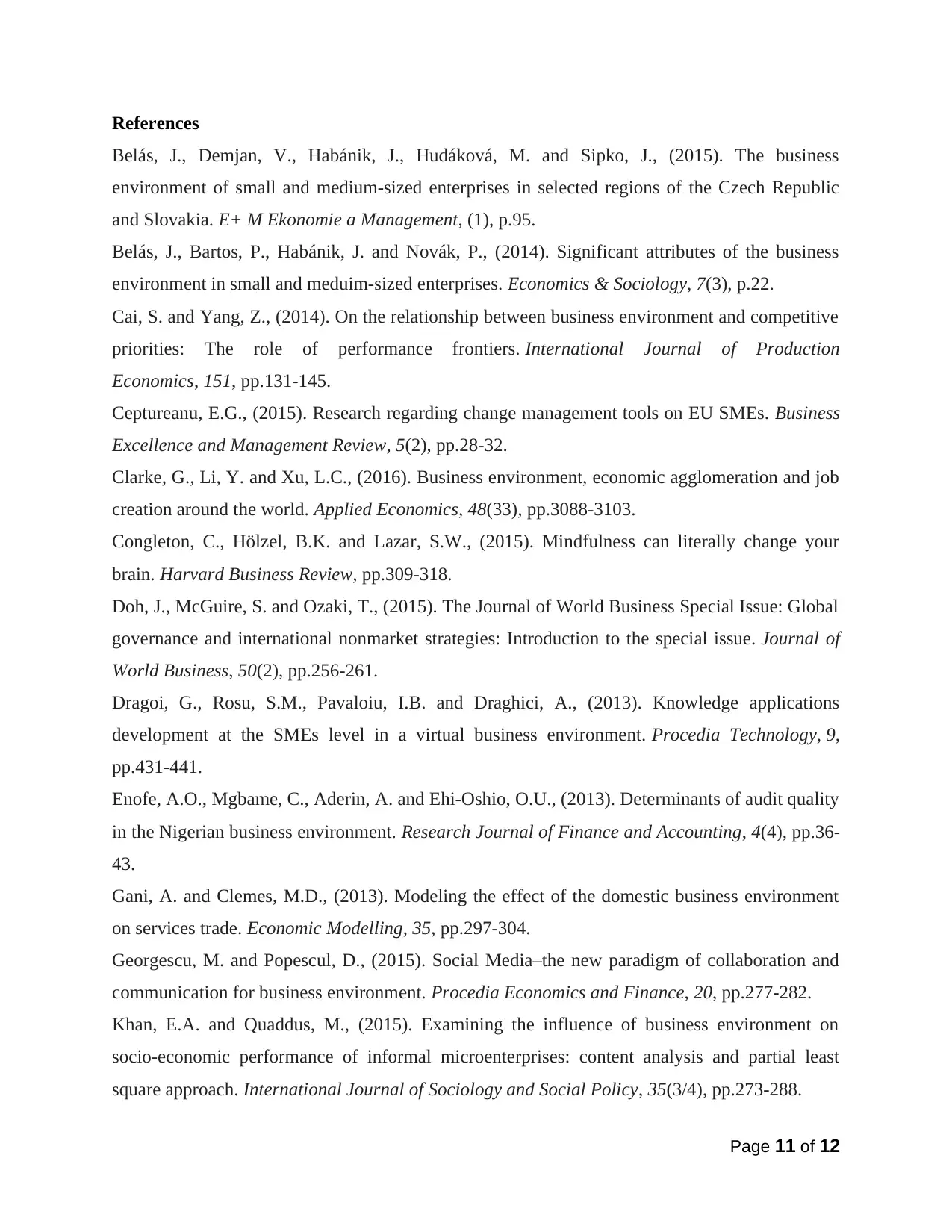
References
Belás, J., Demjan, V., Habánik, J., Hudáková, M. and Sipko, J., (2015). The business
environment of small and medium-sized enterprises in selected regions of the Czech Republic
and Slovakia. E+ M Ekonomie a Management, (1), p.95.
Belás, J., Bartos, P., Habánik, J. and Novák, P., (2014). Significant attributes of the business
environment in small and meduim-sized enterprises. Economics & Sociology, 7(3), p.22.
Cai, S. and Yang, Z., (2014). On the relationship between business environment and competitive
priorities: The role of performance frontiers. International Journal of Production
Economics, 151, pp.131-145.
Ceptureanu, E.G., (2015). Research regarding change management tools on EU SMEs. Business
Excellence and Management Review, 5(2), pp.28-32.
Clarke, G., Li, Y. and Xu, L.C., (2016). Business environment, economic agglomeration and job
creation around the world. Applied Economics, 48(33), pp.3088-3103.
Congleton, C., Hölzel, B.K. and Lazar, S.W., (2015). Mindfulness can literally change your
brain. Harvard Business Review, pp.309-318.
Doh, J., McGuire, S. and Ozaki, T., (2015). The Journal of World Business Special Issue: Global
governance and international nonmarket strategies: Introduction to the special issue. Journal of
World Business, 50(2), pp.256-261.
Dragoi, G., Rosu, S.M., Pavaloiu, I.B. and Draghici, A., (2013). Knowledge applications
development at the SMEs level in a virtual business environment. Procedia Technology, 9,
pp.431-441.
Enofe, A.O., Mgbame, C., Aderin, A. and Ehi-Oshio, O.U., (2013). Determinants of audit quality
in the Nigerian business environment. Research Journal of Finance and Accounting, 4(4), pp.36-
43.
Gani, A. and Clemes, M.D., (2013). Modeling the effect of the domestic business environment
on services trade. Economic Modelling, 35, pp.297-304.
Georgescu, M. and Popescul, D., (2015). Social Media–the new paradigm of collaboration and
communication for business environment. Procedia Economics and Finance, 20, pp.277-282.
Khan, E.A. and Quaddus, M., (2015). Examining the influence of business environment on
socio-economic performance of informal microenterprises: content analysis and partial least
square approach. International Journal of Sociology and Social Policy, 35(3/4), pp.273-288.
Page 11 of 12
Belás, J., Demjan, V., Habánik, J., Hudáková, M. and Sipko, J., (2015). The business
environment of small and medium-sized enterprises in selected regions of the Czech Republic
and Slovakia. E+ M Ekonomie a Management, (1), p.95.
Belás, J., Bartos, P., Habánik, J. and Novák, P., (2014). Significant attributes of the business
environment in small and meduim-sized enterprises. Economics & Sociology, 7(3), p.22.
Cai, S. and Yang, Z., (2014). On the relationship between business environment and competitive
priorities: The role of performance frontiers. International Journal of Production
Economics, 151, pp.131-145.
Ceptureanu, E.G., (2015). Research regarding change management tools on EU SMEs. Business
Excellence and Management Review, 5(2), pp.28-32.
Clarke, G., Li, Y. and Xu, L.C., (2016). Business environment, economic agglomeration and job
creation around the world. Applied Economics, 48(33), pp.3088-3103.
Congleton, C., Hölzel, B.K. and Lazar, S.W., (2015). Mindfulness can literally change your
brain. Harvard Business Review, pp.309-318.
Doh, J., McGuire, S. and Ozaki, T., (2015). The Journal of World Business Special Issue: Global
governance and international nonmarket strategies: Introduction to the special issue. Journal of
World Business, 50(2), pp.256-261.
Dragoi, G., Rosu, S.M., Pavaloiu, I.B. and Draghici, A., (2013). Knowledge applications
development at the SMEs level in a virtual business environment. Procedia Technology, 9,
pp.431-441.
Enofe, A.O., Mgbame, C., Aderin, A. and Ehi-Oshio, O.U., (2013). Determinants of audit quality
in the Nigerian business environment. Research Journal of Finance and Accounting, 4(4), pp.36-
43.
Gani, A. and Clemes, M.D., (2013). Modeling the effect of the domestic business environment
on services trade. Economic Modelling, 35, pp.297-304.
Georgescu, M. and Popescul, D., (2015). Social Media–the new paradigm of collaboration and
communication for business environment. Procedia Economics and Finance, 20, pp.277-282.
Khan, E.A. and Quaddus, M., (2015). Examining the influence of business environment on
socio-economic performance of informal microenterprises: content analysis and partial least
square approach. International Journal of Sociology and Social Policy, 35(3/4), pp.273-288.
Page 11 of 12
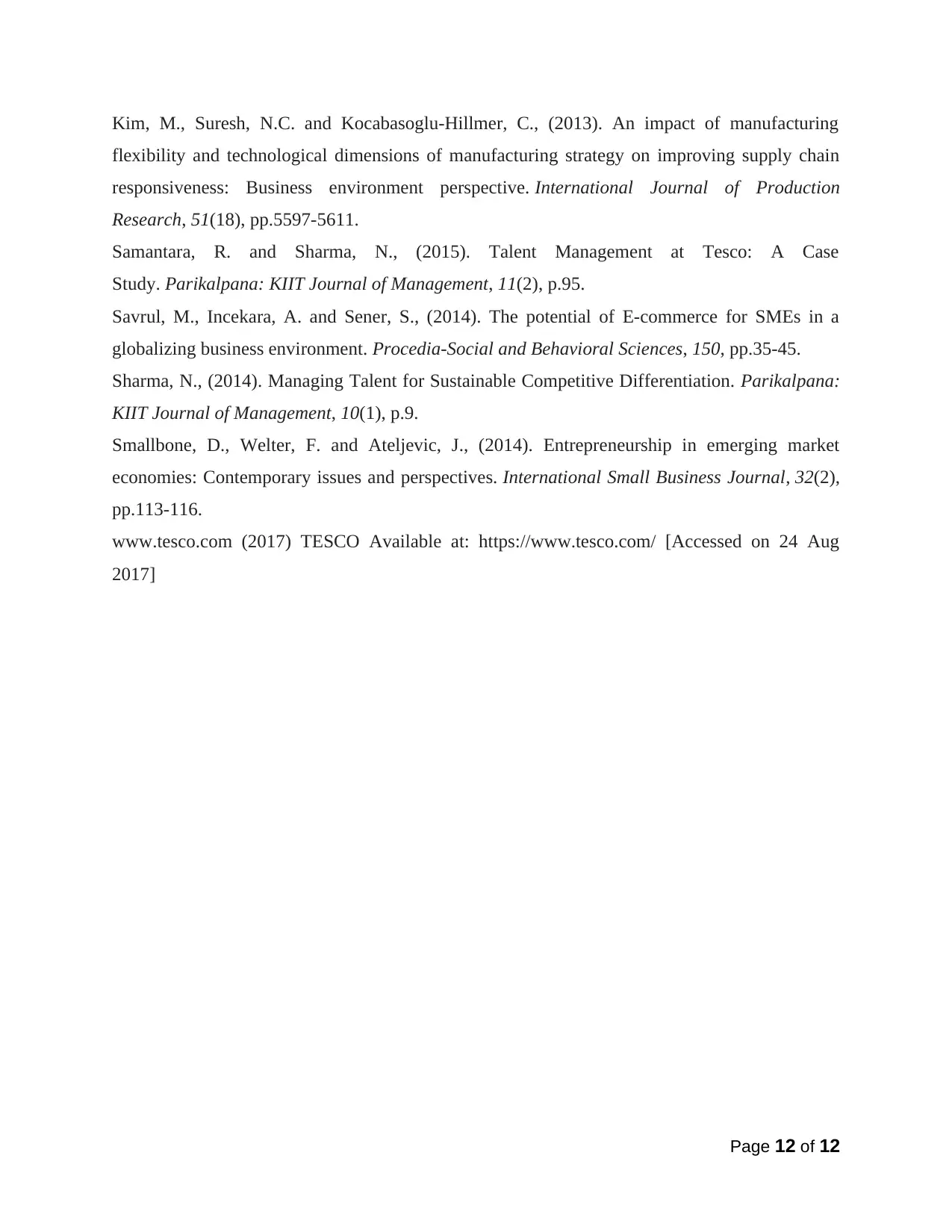
Kim, M., Suresh, N.C. and Kocabasoglu-Hillmer, C., (2013). An impact of manufacturing
flexibility and technological dimensions of manufacturing strategy on improving supply chain
responsiveness: Business environment perspective. International Journal of Production
Research, 51(18), pp.5597-5611.
Samantara, R. and Sharma, N., (2015). Talent Management at Tesco: A Case
Study. Parikalpana: KIIT Journal of Management, 11(2), p.95.
Savrul, M., Incekara, A. and Sener, S., (2014). The potential of E-commerce for SMEs in a
globalizing business environment. Procedia-Social and Behavioral Sciences, 150, pp.35-45.
Sharma, N., (2014). Managing Talent for Sustainable Competitive Differentiation. Parikalpana:
KIIT Journal of Management, 10(1), p.9.
Smallbone, D., Welter, F. and Ateljevic, J., (2014). Entrepreneurship in emerging market
economies: Contemporary issues and perspectives. International Small Business Journal, 32(2),
pp.113-116.
www.tesco.com (2017) TESCO Available at: https://www.tesco.com/ [Accessed on 24 Aug
2017]
Page 12 of 12
flexibility and technological dimensions of manufacturing strategy on improving supply chain
responsiveness: Business environment perspective. International Journal of Production
Research, 51(18), pp.5597-5611.
Samantara, R. and Sharma, N., (2015). Talent Management at Tesco: A Case
Study. Parikalpana: KIIT Journal of Management, 11(2), p.95.
Savrul, M., Incekara, A. and Sener, S., (2014). The potential of E-commerce for SMEs in a
globalizing business environment. Procedia-Social and Behavioral Sciences, 150, pp.35-45.
Sharma, N., (2014). Managing Talent for Sustainable Competitive Differentiation. Parikalpana:
KIIT Journal of Management, 10(1), p.9.
Smallbone, D., Welter, F. and Ateljevic, J., (2014). Entrepreneurship in emerging market
economies: Contemporary issues and perspectives. International Small Business Journal, 32(2),
pp.113-116.
www.tesco.com (2017) TESCO Available at: https://www.tesco.com/ [Accessed on 24 Aug
2017]
Page 12 of 12
⊘ This is a preview!⊘
Do you want full access?
Subscribe today to unlock all pages.

Trusted by 1+ million students worldwide
1 out of 12
Related Documents
Your All-in-One AI-Powered Toolkit for Academic Success.
+13062052269
info@desklib.com
Available 24*7 on WhatsApp / Email
![[object Object]](/_next/static/media/star-bottom.7253800d.svg)
Unlock your academic potential
Copyright © 2020–2025 A2Z Services. All Rights Reserved. Developed and managed by ZUCOL.





